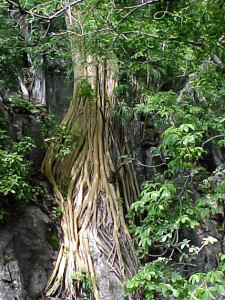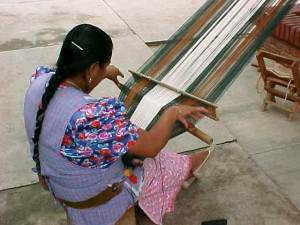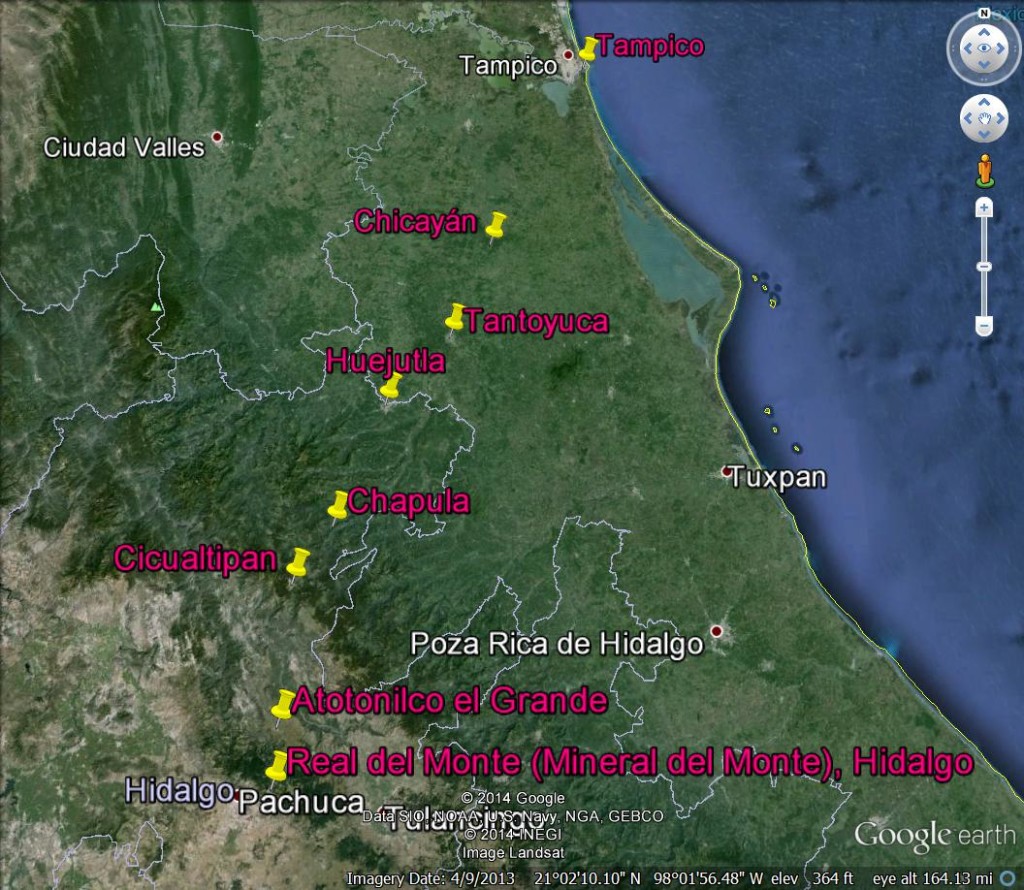This is a continuation of a previous post about a journey from New York to the Mexican mining town of Real del Monte (Mineral del Monte) undertaken by a detachment sent by the Real del Monte Mining Company in 1824. The men had landed in Tampico and had come through the hot lowlands of the gulf coast. They were now moving inland through the rain from the area of Rancho los Alacranes near the Chicayan river toward the mountains.
I found the commentaries about the countryside, flora, fauna, and peoples of the areas through which the detachment traveled–and the fact that the events of this journal led, in one way or another, to Mexico’s fascination with the sport of football soccer–quite entertaining.
The detachment passed a number of ranches during the day’s trek before settling for the evening at the casa del comun (public inn) of Tantoyuca. The author remarked on the presence of cultivated fields–which until this point the men had not seen–a school, a church and a few shops. He says, “I had an abundance of most delicious pines [pineapples] here, very cheap, plantains, which differ from the ficus banana in being larger and less sweet, guava jelly, and ahuacates. This fruit, which is a favourite dish with the natives, is eaten either with boiled meat or simply with a little salt.”
On June 1, continued bad weather kept the detachment in Tantoyuca.
On June 2, as the mule train moved toward higher country, passing Huejutla, Ranchos Tepatlan, and Ranchos el Calabozo, the author describes the changing flora and fauna and exclaims at the presence of shells, “the inside of which is very much like mother of pearl,” in the riverbed of the Rio Calabozo. Near Baguta and Hacienda de las Flores, he sees his first round hut (the coastal huts were all square) and spots two species of deer “of extraordinary beauty.” Of the countryside through which they were passing, he says, “The mountains which are now near us and which rise before us like steps, were tinged with colours which I believe are not to be beheld under any other sky.”
June 3 found the caravan moving through “an atmosphere perfumed with balsamic odours; a variety of gay and beautiful birds, and of the loveliest flowers …” Here, their ascent into the mountains truly began, and they climbed to the mesa of Gohautla from whence they were treated to a view of the whole extension of the terrain through which they’d already passed.
“Here, I ate some tortillas (a sort of cake) and drank a little pulque, which are not precisely ambrosia and nectar …”
Overnighting in the settlement of Gohautla, our traveler describes the indigenous people of the area as having “a remarkable physiognomy: aquiline noses and regular features, instead of the flat nose and thick lips of the people of the plains. They let their hair grow and turn it up over the left ear.”
The writer regales us with tales told him by an “American of Spanish race” in Gohautla who “attached himself in so distressing a manner to me, that in spite of a considerable degree of incivility on my part, I could not shake him off.” This “bore,” as our writer calls him, told him of “a serpent with four mouths whose bite produced the most extraordinary and horrible effects” and of a switch cut from a particular hedge that “possessed more miraculous properties than Moses’s rod” and that when “held in the hand, it was an effectual preservative against the bite of venomous serpents.”

June 4 finds our man passing through forests and remarking in detail on an unusual tree: “It clings to every plant within its reach with so tenacious a grasp that it is not uncommon to see two trees of considerable size bent towards each other by its force, and still more common to see a group of trees so closely bound together as to form only one in appearance.” This, to me, sounds like the amate, or wild fig tree. The day’s journey ends at a cluster of huts called Huayahual on the banks of the Garces (later the La Cañada) river.
Here in Huayahual, the writer describes a back-strap loom being used by the mistress of the house into which they were welcomed that night: “[I]t consisted of two pieces of wood, upon which the warp was stretched; one of these was fixed to a nail, and the other tied across the body of the weaver; there was a stay which the poor woman was obliged to raise with her left hand whenever she wished to pass, with her right, a long reel upon which the cotton she was weaving was wound. The machinery was completed by a stick, with which she beat the woof in order to render the web as fine as even as possible.”

On June 5, the detachment entered what seems to be one of the most treacherous stretches of terrain along the river La Cañada. “It is necessary to watch every step of your mule, or you are in danger of plunging into the deposits of mud which it leaves along its banks. […] The two sides of the ravine are perfectly perpendicular; they are at so small a distance form each other, and so lofty, that they exclude the view of every thing but a narrow strip of sky, and seem to threaten instant destruction to the passenger.”
Stopping for the night at the village of Tlacolula, where the huts were “no longer covered with palm leaves […] but with the leaves of the maize, which are very ill adapted for the purpose,” the contingent divided into two parties, one of which bedded down in the tiny casa del comun, which was too small to house the whole group, while the other proceeded to the house of the local curate.
“I thought I was entering a seraglio instead of a dwelling devoted to celibacy. [The priest] was sitting in his porch, without his shirt, and surrounded by a troop of hand-maidens…” The priest and his women greeted the travelers with ill humor and refused them shelter, even after being offered wine; however, once the friar himself arrived (who did appreciate their gesture of the gift of wine), the contingent was allowed to stretch out “on the floor of the sitting-room in our cloaks, while the reverend father and his two chief ladies occupied the adjoining room.”
On the morning of June 6, the detachment was not allowed to proceed on its journey until it first attended a lengthy mass followed by a species of court session in which a legal matter had to be settled that involved the ownership two fowls. After a late start, they were unable to get any farther than the town of Chapula, where they settled again into the local casa del comun.
June 7: “The road presents new beauties of an ever varying character. […] I saw many turkeys (coagolotes) in their wild state…” Nevertheless, this stretch, known as the Caracol, is described as another dangerous passage involving more than twenty-two crossings of the river La Cañada. In fact, the writer points out here that on the whole route, their caravan will have crossed river La Cañada a total of more than one hundred and fourteen times.
Their arrival at the settlement of Piñolco, a grouping of some five or six houses, provided respite for the travelers. “The climate and productions are precisely those of the Italian Tyrol; the air was fresh, and it seemed a cool September day in that country.”
The following day, June 8, brought the mule train through a more populated area with better stretches of road and scatterings of small villages. “Our attention was frequently attracted by seeing one field of wheat ripe and another close to it just covering the earth with a green surface. Nothing is more common here than to see the flower and the fruit on the same tree.”
Upon coming out of the rugged mountains and arriving finally at the town of Cicualtipan (today known as Zacualtipan), our man writes: “Not so great was the joy of the Crusaders at the first sight of the Holy City, as ours on descrying Cicualltipan […]. The houses here are in the form of houses and not of mouse traps. They have doors and door-posts and windows. […] The entrance to the town lies through orchards filled with grapes, figs, medlars, peaches, apples, elderberries, and other European fruits.”
The writer calls Cicualtipan a division between the world of beauty and the world of barrenness and horror. “On the one side, the country is all fertility and loveliness; a stone’s throw on the other, it is bare, rugged, and desert.”
On June 9, moving out of Cicualtipan, the caravan followed the river Ocucalco through this new, stark terrain until they were assailed by yet another abrupt contrast: the wider and more fertile valley of the Rio Grande (obviously not the one that runs along the Mexico-US border).
“It would perhaps be difficult to find a more fertile spot. The maize here grows to nearly twice its ordinary height; the cotton, the esculent vegetables, the fruit trees, show by their vigorous foliage that vegetation is here in its fullest activity.”
On the other side of this refreshing interlude, though, the barren monotony continued: “The ground is flat, the cacti have disappeared or are rarely met with, not a tree is to be seen; the short burnt grass furnishes a scanty and unwholesome food to the unfortunate cattle, who weary themselves in searching for pasture.” Few habitations were to be seen, and the ground was riddled with anthills. The men halted and took lodging that night in the town of Atotonilco el Grande.
From Atotonilco el Grande, it was but a short trek to Real del Monte on June 10, but here, dear reader, we are let down dramatically. Our man writes: “At noon we made our solemn and triumphal entry into Real del Monte, or into the place where Real del Monte once existed, and where it will ere long raise its head again. […] The roofs are perforated and falling in, the walls crumbling down, and, in short, the whole village converted into a mass of ruins. […] The causes of this decay are obvious enough. This district has no resources when the mines are not worked, which has been the case at Real del Monte for a long time past.”
Apparently, the writer’s only remaining duty was to inspect the area for a few days and report on the realities of Real del Monte and its peoples. The last few pages of the book, with entries dated June 11, 12, 13, and 16, detail these observations.
The writer visited nearby estates and haciendas, many of which were in disrepair, and took a trip into the nearby city of Pachuca, upon which he commented most favorably.
He complains of the constant cold and rain of Real del Monte, even though, he says, Pachuca has a totally different and much more clement climate. “I can at present tell you little about my new abode, except that it rains every day, and that very often while you are refreshing yourself with ices, I am cowering over the fire.”
Of the local Indians, he says, “[T]hey are all the gentlest creatures in the world; They are not handsome, but they have nothing repulsive in their physiognomy; their black eyes are, on the contrary, expressive and interesting. [ … ] They are somewhat distrustful, but can it be wondered at that they have learned this lesson from their long and bitter experience.”
The author details for his company the soaking of maize, grinding of the corn, and subsequent formation by hand of the tortillas by the local women. He explains the steps of the fermentation process for the elaboration of pulque. He mentions many times that he found the natives devoid of curiosity and lacking in ambition, yet he extols their honesty and respect for the property of others.
Our man concludes his report astutely by distancing himself from any political leanings or opinions, simply saying, “I say nothing about the political state of the country, because I esteem it one of the great advantages of my present situation to known nothing of the politics of any part of the world.”
Did you know:
After this journey was undertaken, the Real del Monte Mining Company put the Real del Monte mines, first worked in Colonial times, back into production after a significant period of abandonment and decline, bringing in Cornish miners from Britain to work them. The miners brought their customs and sports with them, one of which was football soccer, and formed Mexico’s first soccer club, the Real del Monte Pachuca Athletic Club (see http://www.cornish-mining.org.uk/delving-deeper/sports for more).
To this day, Mexicans refer to the Pachuca football team as the Tuzos, or gophers, a nickname stemming from the underground life of the miner’s who first formed the team.

III.Journal descriptive of the Route from New York to Real del Monte by way of Tampico
By one of the first Detachment sent by the Real del Monte company
July 16, 1824
Reprinted in Pachuca, Hidalgo, Mexico, December 1939.
More information:
“The mining town of Real del Monte brings color from another era,” http://mexicotoday.org/article/mining-town-real-del-monte-brings-color-another-era
“Real del Monte, Hidalgo,” VisitMexico.com, http://www.visitmexico.com/en/magicaltowns/center-region/real-del-monte
Wikipedia contributors, “C.F. Pachuca,” Wikipedia, The Free Encyclopedia, http://en.wikipedia.org/w/index.php?title=C.F._Pachuca&oldid=608768277 [accessed May 16, 2014]
Cornish Mining World Heritage website, http://www.cornish-mining.org.uk/